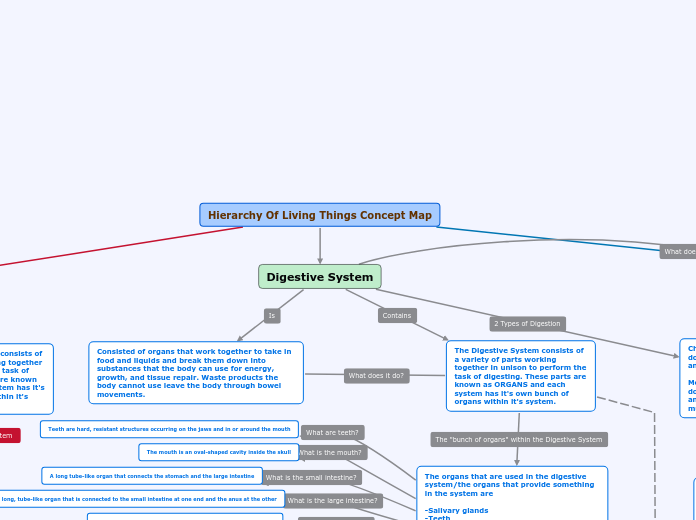"Photo"
Retrieve energy including Light Reactions
BIO 311C Concept Map
Ribosomal subunits and other parts dissociate
Release factor promotes hydrolysis of the bond between tRNA in P site and the last amino acid.
A ribosome reaches the stop codon and the A site accepts a release factor
Cellular Respiration
Photosynthesis
"Synthesis"
Lysosome
Breaks down molecules and recycles them
Endocytosis, three types
Pinocytosis
Phagocytosis
Receptor mediated
Gene Expression
RNA Modifications
RNA splicing
Introns are cut out and exons are spliced together
5' Cap and Poly A Tail
5' cap and Poly A tail are added to the two ends of pre-mRNA molecule in otder to facilitate the export of mature RNA from the nucleus, protect the mRNA from degrading, and help ribosomes attach to the 5' end of the mRNA when it is in the cytoplasm
Transcription
RNA transcript is realsed and polymerase detaches from the DNA
Polymerase moves downstream, unwinding the DNA and elongating the RNA transcription in 5' to 3' direction
RNA Pol binds to promoter, DNA strands unwind, Pol initiates RNA synthesis at start point
Transcription in Eukaryotes
Other transcription factors bind the DNA along with RNA Pol II, forming transcription initiation complex
Transcription factors bind to DNA before RNA Pol II binds to it
TATA box nucleotide sequence (promoter)
Translation
Three Steps
Elongation Cycle
Translocation
Ribosome transolcates tRNA from A site to P site. Empty tRNA in P site moved to E site to get released.
Peptide bond formation
Codon Recognition
Anticodon of aminoacyl tRNA base pairs with complementary mRNA codon in A site. Binds and proceeds
Large ribosomal unit completes initiation complex. Initiation factors in charge of connection of all translation components.
Small ribosomal unit binds to mRNA. Initiator tRNA binds with start codon
Process in which protein is synthesized
Cell Signaling
Membrane Receptors
Ion Channel receptor
Membrane bound receptor undergoes conformational change, allows for passage of ions
Tyrosine kinase receptor
Allows transfer of phosphate from ATP to tyrosine kinase regions of dimer
G-protein coupled receptor
Cell surgace transmembrane receptor that works with help of G protein
Signal Molecules
Hydrophilic
Receptor on/in plasma membrane
Hydrophobic
Receptor in cell nucleus
Receptor in cell cytoplasm
Types of cell signaling
Local
Synaptic
Neurotransmitters released and diffuses across synapse, stimulating target cell
Paracrine
Direct signaling
Stages of cell signaling
Cellular response: Transduced signal triggers response
Transduction: Receptor protein changes when signal molecule binds to it. Signal conveyed to form that can bring cellular response. Signal transduction pathway
Reception: Signal molecule binds to receptor protein located at cell's surface
Gene Regulation
Transcription factors
Specific transcription lead to increased expression
Distal control elements are enhancers that are located upstream/downstream of a gene
Activators bind to enhancer and bends sequence
General factors leads to basal level transcription
Proximal control elements are close to promoter
Transcription factors bind to proximal elements and transcription is low
Allows RNA Pol II to bind
Repressor binds to enhancer and prevents RNA Pol II to bind
Tryptophan
Tryptophan present, repressor active, operon off
Tryptophan absent, repressor inactivated, operon on
Negative regulator because binds to repressor
Amino acid
cAMP levels
Lactose and glucose present means low cAMP levels and CAP is inactivated
Lactose present, glucose absent means high cAMP levels and activated CAP
Operon on
Lactose present, repressor inactive, operon on
Operon off
Lactose absent, repressor on, operon off
Lac Operon
Required for transport and metabolism of lactose
Lac I is lac repressor
Lac A adds acidicyl group to lactoes
Lac Y takes in lactose
Lac Z forms mRNA
Prokaryotes
Operator is not in Eukaryotes
Multiple genes controlled by same promoter
Operons are present
DNA Packaging
DNA packaged with proteins into chromatin
Histone core is a protein that binds the DNA
Nucleosomes formed when DNA wraps around histone twice
Interactions between nucleosomes cause thin fiber to coil or fold into thicker fiber
Tight helical fiber needs help of H1
Nucleosomes strung together
H1 is not a part of the core
H1, H2A, H2B, H3, H4
DNA Replication
Steps of Replication
Termination
Elongation
Primer starts making leading strand and uses the existing strand as a template strand. DNA Pol III puts on new bases and lagging strand is synthesized in okazaki fragments. DNA ligase attaches these fragments together
Initiation
Begins at ORI, helicase unwinds DNA. Topoisomerase releases tension. RNA primers are created
DNA structure
Bases
Cytosine
Guanine
Thymine
Adenine
Semi-conservative
Messeleson and Stahl
Strands separated and template synthesizes new complementary strand
Cell Division
Cell communication
Cells signals one another to tell other cells to begin replication, starting at the phospholipid bilayer
Signal molecules are attached to the phospholipid bilayer and cellular processes begin with the attachment to a receptor molecule
DNA Synthesis
Origin of Replication
Point in DNA where replication begins
Replication fork
Where the DNA begins to separate
Lagging strand
Synthesizes in direction away from fork
Leading Strand
Synthesizes in direction towards replication fork
Enzymes involved with DNA
Topoisomerase
Relieves strain on DNA strands
Ligase
Connects DNA
DNA Polymerase I
Removes RNA primers and replaces with DNA
DNA Polymerase III
Synthesizes new DNA strands
Primase
Creates RNA primer and attaches on at 5' end of leading strand and multiple on lagging strand
Helicase
Unwinds double helix at replication forks
Cell Components
Golgi Apparatus
Gives instructions to proteins and transports them
Endoplasmic Reticulum
Synthesizes lipids in smooth ER
Synthesizes protein in rough ER
Ribosomes
Synthesizes proteins, made of RNA and proteins
Can be free or bound
Proteins
Nucleus
Contains all genetic information of a cell
Vacuole
Contains liquids in cell, two types
Food vacuole
Central vacuole
Cytoplasm
Place where cell components stay
Cell Wall
Protective wall made of cellulose of chitin
Mitochondria
Supplies and produces energy for cellular processes
Phospholipid Bilayer
Membrane made up of two fatty acid tails and a hydrophilic head
Glycerol
Fatty acids
Lipids
Present in plants
Triglycerides
Unsaturated
Oils, kinks
Saturated









